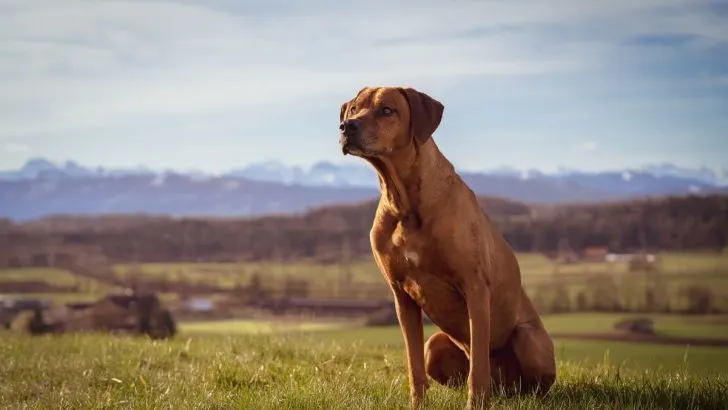Hey there, fellow dog enthusiasts!
Is a Rhodesian Ridgeback a medium or a large breed? Well, it is both! Our Rhodesian Ridgeback growth chart is going to show you just how big these dogs can get.
These athletic dogs are known for their intelligence, loyalty, and that signature ridge of hair running along their back in the opposite direction.
This unique and fun feature makes them stand out from other dog breeds.
Let’s take a look and see what to expect as your pup grows into a magnificent adult.
Rhodesian Ridgeback Weights & Heights Overview
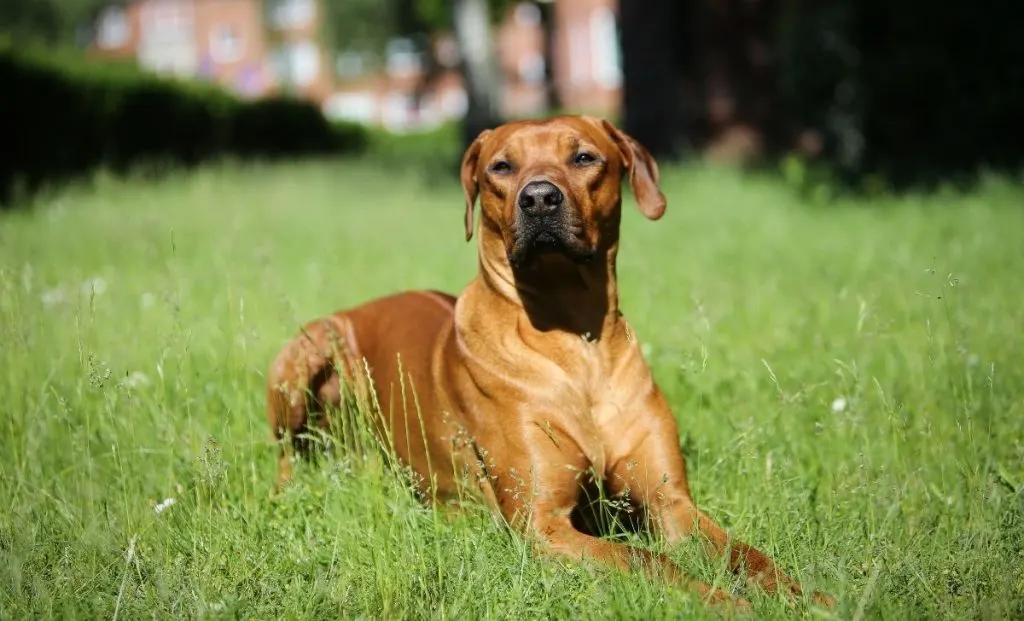
Did you know that the Rhodesian Ridgeback, originally bred in Africa, has a historical role in tracking lions?
Imagine how much power these dogs have to be able to do these tasks!
To help them grow into such fearless and healthy adults, we need to know a bit more about the typical growth patterns of your Rhodesian Ridgeback.
Here’s a handy table summarizing the typical growth milestones for these dogs, giving you a good place to start.
Keep in mind, though, the following chart presents only the average weights and heights of these majestic dogs.
| Age (Months) | Weight (lbs) | Height (inches) |
| 2 | 15-20 | 10-12 |
| 4 | 30-40 | 15-17 |
| 6 | 45-60 | 18-22 |
| 8 | 55-70 | 20-24 |
| 10 | 65-80 | 22-26 |
| 12 | 70-85 | 24-27 |
| 18 | 75-95 | 25-27 |
This Rhodesian Ridgeback size chart is a good way to keep track of your dog’s development, but remember that individual dogs might grow at different rates.
This especially goes for Rhodesian Ridgeback mixes, which can have varied growth patterns due to their mixed heritage.
For a more accurate estimate, you can search for growth chart calculators online. These tools are very handy for all dog breeds.
I also want to mention that there are differences in male and female Rhodesian Ridgebacks in terms of size.
This is a common characteristic among medium to large breeds. So, let’s get into that a bit.
Rhodesian Ridgeback Male Growth Chart
Alright, we all know that male Rhodesian Ridgeback dogs are big, goofy, and often gentle giants, known for their endearing personalities. But, how big are they?
| Age (Months) | Weight (lbs) | Height (inches) |
| 1 | 10-15 | 8-10 |
| 3 | 20-30 | 12-14 |
| 6 | 45-60 | 18-22 |
| 9 | 60-75 | 21-25 |
| 12 | 70-85 | 24-27 |
| 18 | 75-95 | 25-27 |
According to the official Rhodesian Ridgeback breed standards by the American Kennel Club, these dogs should have a well-balanced, symmetrical appearance, with a strong, muscular build.
When compared to his female counterpart, the male Rhodesian is usually on the taller side.
Thanks to their heritage of hunting lions and protecting homesteads in Africa, these dogs were selectively bred for their impressive size and strength.
Isn’t it fascinating how their historical role has shaped them into the strong, reliable, and majestic companions we adore today?
Rhodesian Ridgeback Female Growth Chart
Now, female Rhodesian Ridgeback weights and heights are a bit different than the males.
Female Rhodesian Ridgebacks are big dogs that are known for their elegant yet sturdy appearance.
They have a well-balanced, symmetrical build with strong muscles that hint at their athletic nature.
| Age (Months) | Weight (lbs) | Height (inches) |
| 1 | 9-14 | 7-9 |
| 3 | 18-25 | 11-14 |
| 6 | 35-50 | 17-22 |
| 9 | 50-65 | 20-25 |
| 12 | 60-75 | 23-27 |
| 18 | 65-85 | 24-28 |
As you can see, their average height is smaller than that of a male Ridgeback. But that does not mean that these girls are any less majestic!
Despite their robust appearance, these ladies move with grace and agility, proving that they’re not just powerful but also incredibly elegant companions.
Rhodesian Ridgeback Puppy Growth Chart
It feels like just yesterday your Rhodesian Ridgeback puppies were snuggling up to their mother, and now they’re exploring the world with boundless curiosity.
Let’s get more into their rapid growth, as they stumble and learn new things every day.
Birth To 2 Months
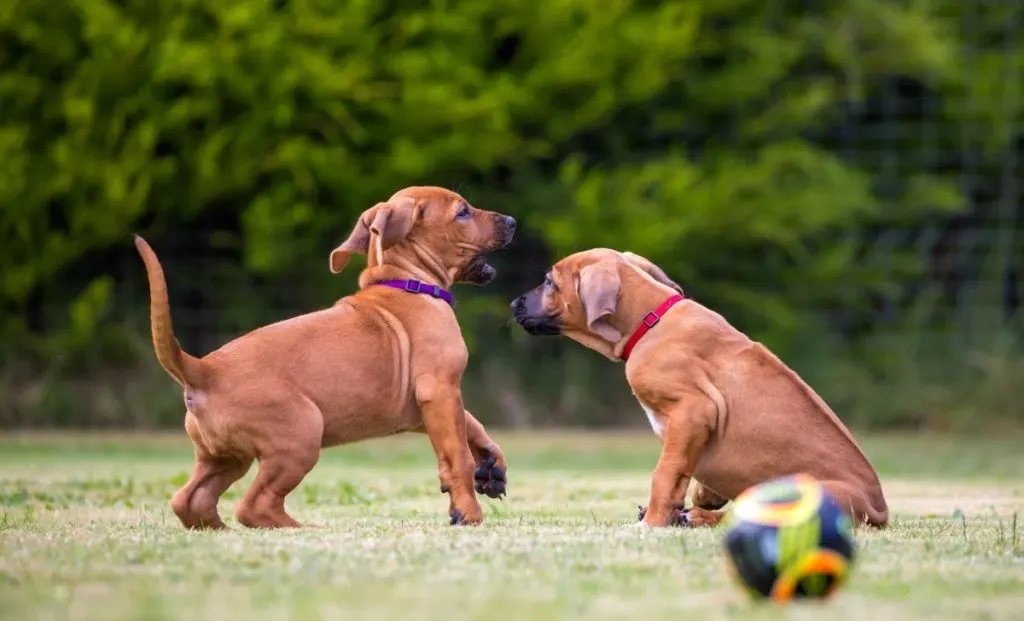
Puppies of Rhodesian Ridgebacks weigh between one and one and a half pounds at birth. They are blind and deaf for the first month and mostly rely on their mother for food and warmth.
They weigh between 9 and 14 pounds at the end of the first month, and their senses are beginning to develop.
At this point, their baby teeth begin to erupt and they start switching from their mother’s milk to soft puppy food (weaning)
They weigh between 15 and 20 pounds at two months, and 18 to 25 pounds at three.
As they grow more lively and inquisitive, investigating their environment and interacting with humans and other littermates more, their level of activity rises.
They may cry at certain times, so it’s important to create a schedule and offer comfort.
2 to 4 Months
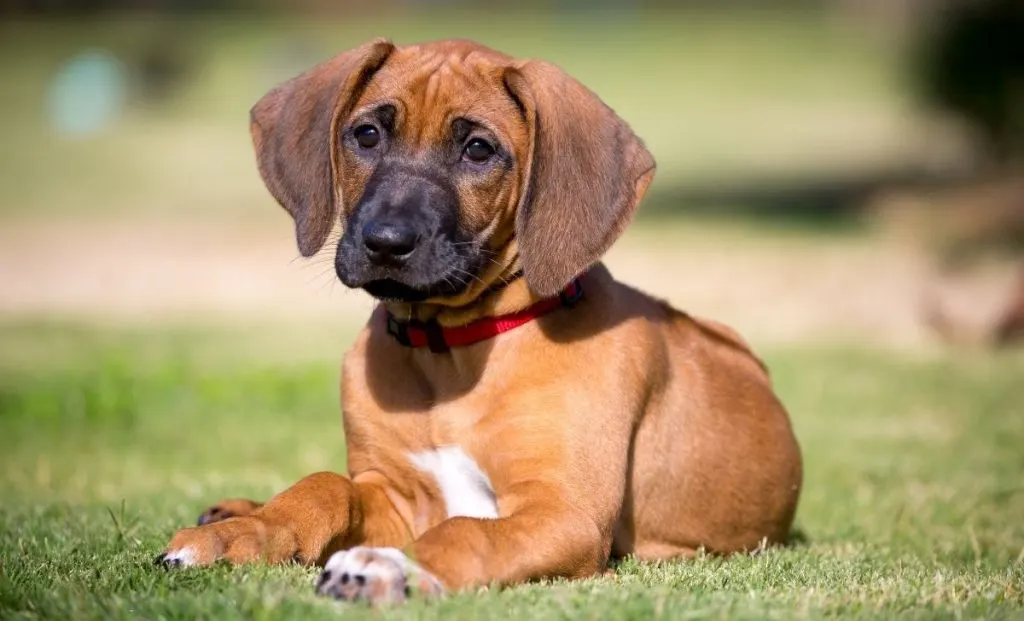
From 2 to 4 months, your Rhodesian Ridgeback puppy will start to experience the onset of rapid growth. During this time, female Rhodesian Ridgeback weights typically range between 15 to 25 pounds.
Right now, these little bundles of joy start showing more of their athletic nature, which is definitely something this dog breed is known for.
So, if you notice high activity levels around this time, that means your puppy is on the right track!
This is a high-energy puppy stage. Your Rhodesian Ridgeback baby will be playful, curious, and eager to explore. It’s the best time for socialization and basic training.
By 4 months, your puppy will weigh between 25 to 35 pounds. Their legs may look a bit too long for their bodies, giving them an adorably awkward appearance.
You might also notice a darker ear on your Rhodesian Ridgeback, often accompanying a darker mask on the face.
Similar dark pigmentation patterns can be found in Belgian Malinois puppies. These puppies frequently have darker masks and ears, which become more prominent as they mature.
With high energy levels comes a good grub. Ensure they are on a balanced diet with high-quality puppy food.
Proper dog food that is filled with protein, vitamins, and minerals supports their rapid growth and helps them develop strong muscles and bones.
4 to 6 Months
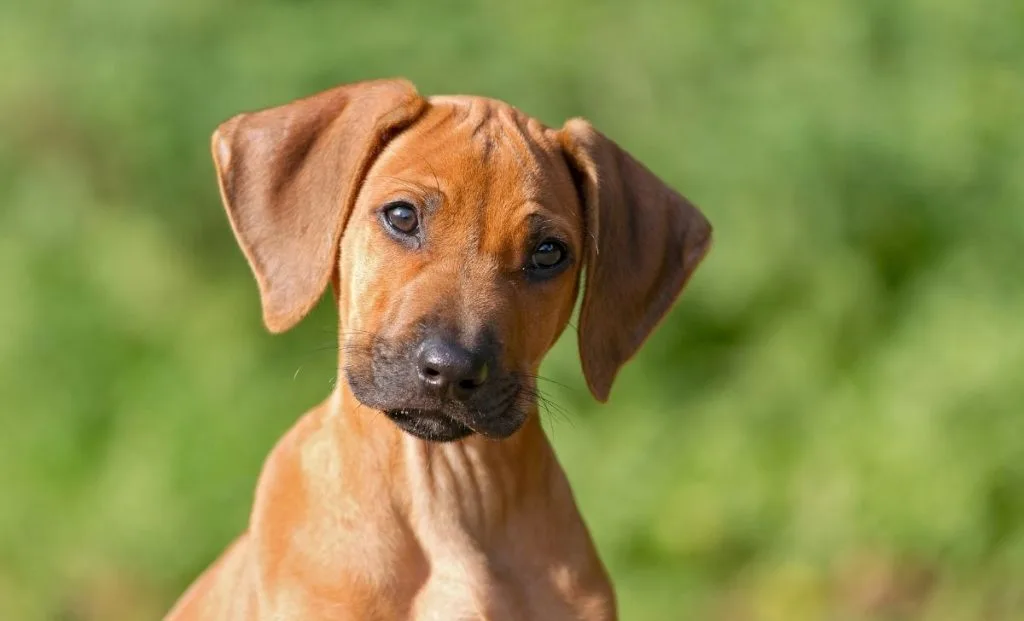
From 4 to 6 months, your Rhodesian Ridgeback puppy continues to grow rapidly.
You may be wondering ‘’How much should a 5 month old Ridgeback weigh?’’
Female Ridgeback weights during this period typically range between 35 to 50 pounds, with males being a bit on the larger side.
You see, regardless of the gender, your puppy’s energy levels remain high. They love to play, run, and explore their surroundings.
At this age, they also start to become more independent and curious. So, you may see them testing boundaries as they gain confidence.
This is completely normal behavior for pups of this age! But, pet parents must make sure to continue with socialization and training.
Their attention span is improving, making it ideal for teaching new commands and tricks.
Therefore, consistent training will help in shaping behavior and paving their path to a healthier and happier dog.
Your Rhodesian Ridgeback puppy is growing fast, so make sure to visit your vet regularly. These visits are crucial in order to pinpoint any signs of potential health problems.
With that being said, it is important to monitor joint health in these big dogs. Why?
Because this dog breed has a tendency to hereditary health problems such as dermoid sinus, generalized skeletal abnormalities, and storage-like diseases, which suggest a possible risk for joint health conditions.
6 To 9 Months
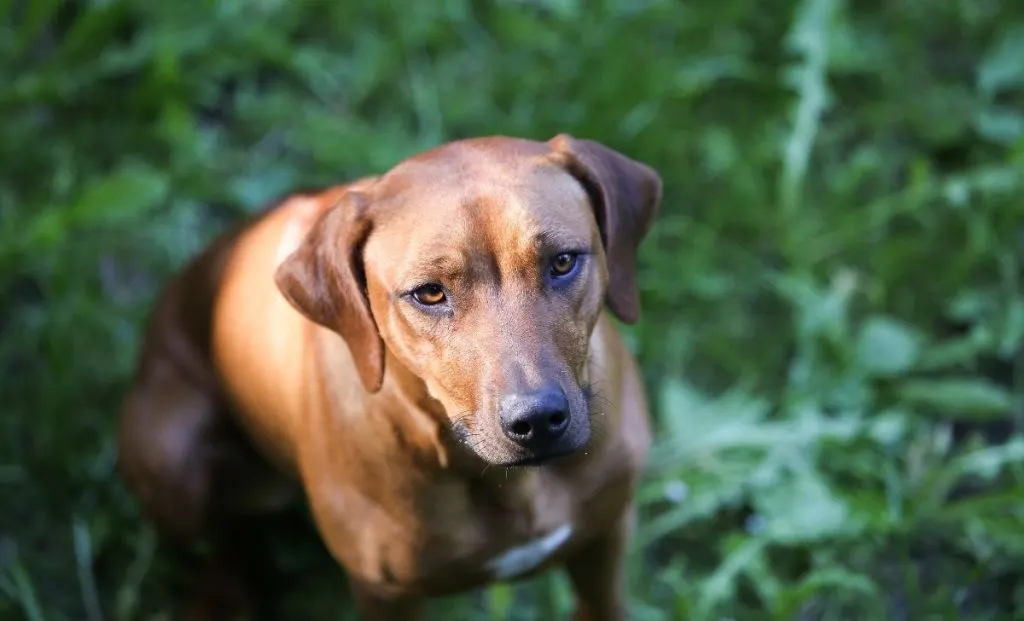
Your Rhodesian Ridgeback is now entering a fun and adventurous puppy stage between 6 to 9 months. This period is full of growth, exploration, and a bit of teenage rebellion.
During these months, your Rhodesian Ridgeback will weigh between 50 to 75 pounds and stand around 20 to 25 inches tall.
They are well on their way to reaching their full size, and their paws may still seem large compared to their bodies, indicating they still have some growing to do.
Regular vet check-ups remain essential to monitor their development and detect any early signs of health conditions.
Maintain a balanced diet with high-quality puppy food and consider adding home cooked food for a good variety. You can make healthy homemade puppy meals with chicken, sweet potatoes, and broccoli.
Their adult teeth should be fully in by now, but they may still enjoy chewing. They are real chewing machines, so don’t be surprised if they are still nibbling on you!
They need plenty of chew toys, so make sure you still have those to satisfy their needs.
Your puppy’s energy and activity levels remain high, and they love some good exercise and quality playtime. This is a great time to introduce new activities and adventures.
From my experience, one common mistake dog owners make during this period is not maintaining a consistent exercise routine.
It’s easy to let busy schedules interfere, but regular exercise is crucial for their physical and mental health.
My advice is to set aside dedicated time each day for walks, play, and training sessions. It not only keeps them fit but also strengthens your bond.
Of course they are going crazy for their favorite tennis ball, but consider new games like hide-and-seek, puzzle toys, or agility courses to keep their minds sharp and bodies active.
Continue with advanced training exercises and make sure that they meet new dogs and people to build their social skills.
9 To 12 Months
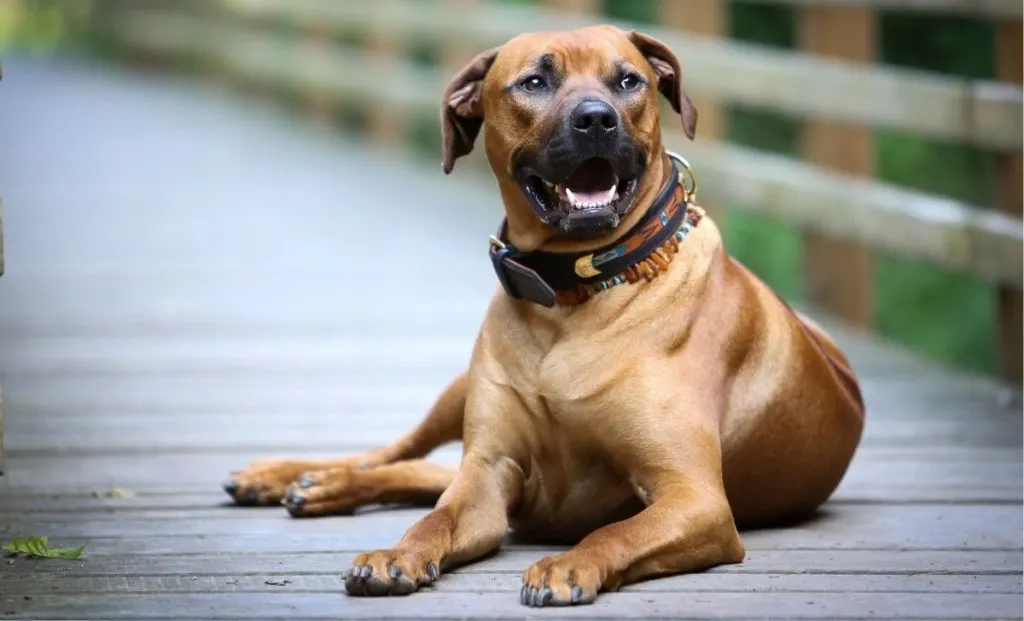
As your Rhodesian Ridgeback enters the 9 to 12 months stage, they are transitioning from puppyhood to adolescence, getting closer to their adult form. Yay! This is such an exciting time.
They are growing and mature into the majestic dogs they’re meant to be.
During this period, Rhodesian Ridgebacks typically weigh between 65 to 85 pounds and stand at a full height of 23 to 27 inches tall.
They are very close to reaching their final sizes, with some last growth spurts fine-tuning their adult proportions.
You’ll notice that while their energy remains high, they’re beginning to exhibit more mature behavior patterns. They might not be as rambunctious as before but will still have a lot of playful moments.
By now, they should have undergone basic training and socialization. Training should continue with a focus on reinforcing the commands and skills they’ve already learned.
Additionally, keeping a consistent exercise routine is one of the best ways for pet parents to manage their Rhodesian’s mental health and maintain a healthy body condition.
Socialization remains crucial, so continue exposing them to different environments, people, and other dogs.
As a vet, I can’t stress enough how important regular visits are even during this period.
In my opinion, these check-ups are crucial for early detection of any potential health issues, giving your furry friend the best chance at a long, healthy life.
At What Age Are Rhodesian Ridgebacks Fully Grown?
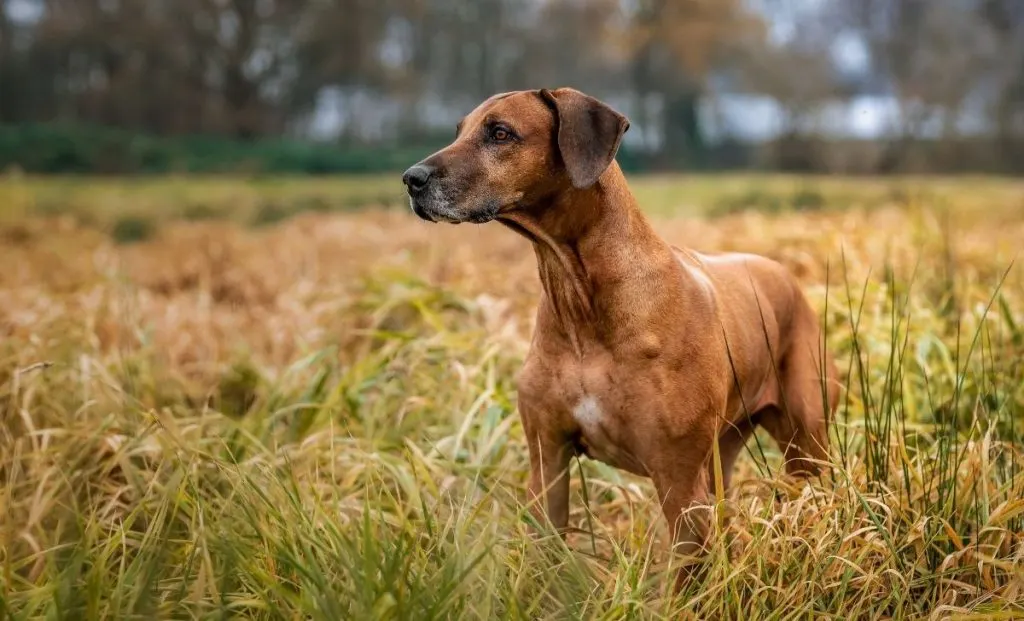
Rhodesian Ridgebacks typically reach their full height and final sizes between 18 to 24 months of age.
By the time they hit 2 years of age, they’re usually around 23 to 27 inches tall and weigh between 65 to 85 pounds.
However, the exact timing can vary depending on the specific dog. Some might fill out a bit earlier, while others take their sweet time getting to their majestic full-grown stature.
A common mistake I see in adult Rhodesians is when their owners neglect socialization.
Some pet parents assume their Ridgeback doesn’t need as much social interaction as they grow older, but this isn’t true.
Continuous socialization helps them remain well-adjusted and confident. So, make sure to keep exposing your dog to various environments, people, and other dogs regularly.
Diet is another area where I see issues.
You see, even though Rhodesian Ridgebacks are not particularly prone to obesity compared to some other breeds like Labrador Retrievers, they can still gain weight if their diet and exercise are not properly managed.
Therefore, make sure to stick to high-quality food formulated for medium to large dog breeds.
Follow your vet’s advice and general guidelines based on their weight and activity level!
How Big Is The Biggest Rhodesian Ridgeback?

Pet parents notice how fast their Ridgebacks grow, and they sometimes wonder, “Will they ever stop?”
During those growth spurts, it feels like they’re getting bigger every day.
I remember one family who brought in their Ridgeback pup for regular check-ups. Each visit, they were amazed at how much he had grown.
They jokingly asked if he would ever stop growing or if they would need to buy a bigger house to accommodate him!
As he reached his adult size, he weighed a whopping 110 pounds and stood about 29 inches tall! He was a gentle giant, and his size was truly awe-inspiring!
And no, he was not an obese pup! His owners understood the importance of closely monitoring his growth.
By monitoring their dog’s weighings and vet check-ups, they soon realized their Ridgeback was simply one of the biggest in the litter.
5 Factors Affecting The Rhodesian Ridgeback Growth
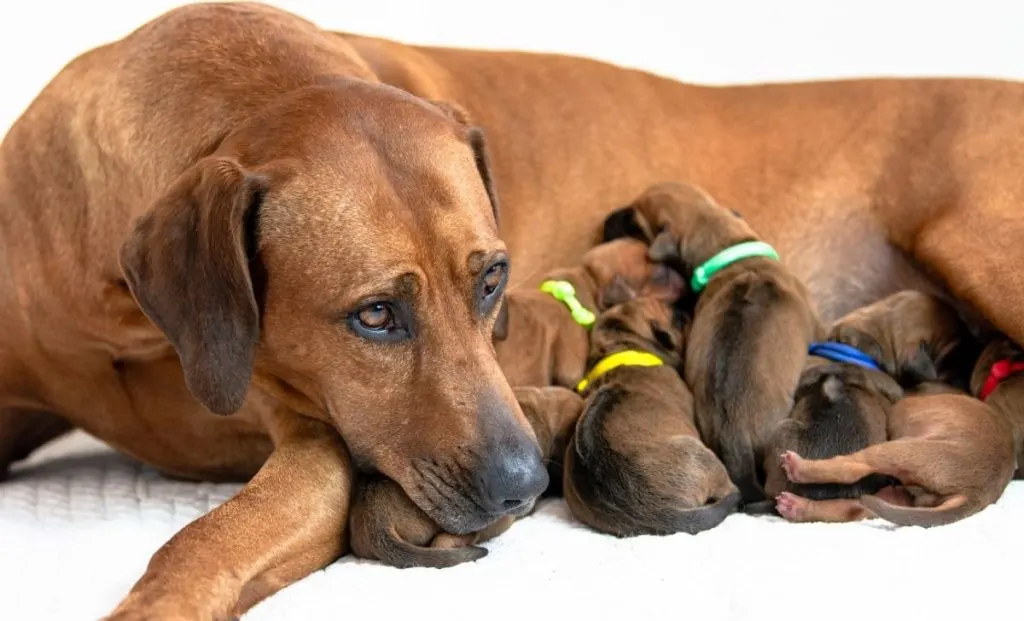
You might wonder, what can make a Rhodesian Ridgeback grow so large?
Well, there are several factors that play a significant role in determining the size of these majestic dogs.
1. Genetics
Genetics are the primary factor of your Ridgeback’s size.
If their parents are large, there’s a good chance they will be too. This inherited trait sets the foundation for their growth potential.
The best way to describe this is if you imagine your Ridgeback’s genetic blueprint like a recipe for a delicious cake. If the ingredients (their parents) are robust and hearty, your pup will likely follow suit.
Apart from their size, the dorsal hair ridge in Rhodesian Ridgebacks is also due to a change in certain genes (1). So, we can blame the genetics for their pawsome looks.
Using a Rhodesian Ridgeback growth chart, you can track your puppy’s development against average sizes.
However, knowing your pup’s parents will give you a better indication of their final size.
2. Nutrition
A balanced diet is very important for healthy Rhodesian Ridgeback growth. It is one of the best ways to maintain your Ridgeback’s body condition and give them the best chance at reaching their final sizes healthily.
Only the best ingredients will help them zoom through their puppy stages and into adulthood. Opt for high-quality puppy food that meets all their nutritional needs. Consider adding home cooked meals too!
Hydration is equally important. Always provide fresh, clean water to keep your puppy hydrated, supporting their overall health and development.
Make sure to avoid overfeeding, as excessive weight gain can lead to health problems.
Most importantly, make sure to avoid toxic foods such as chocolade, candy, fruits with pits, onions and garlic, macadamia nuts, and so on.
3. Exercise
You may have already noticed throughout this article how important exercise is for Rhodesian Ridgebacks.
Ensuring they get plenty of physical activity helps maintain their weight and overall health.
Pet parents should always ensure their Ridgebacks have ample opportunities for exercise.
Activities like running, hiking, and playing fetch are great ways to keep your Ridgeback active and engaged.
4. Health
Health plays a significant role in the Rhodesian Ridgeback growth.
Puppies need a healthy immune system to fight off infections and illnesses that could hinder their development.
A proper vaccination schedule helps protect them from common diseases. Parasite prevention is also important, as infestations can cause weight loss and nutrient deficiencies.
Therefore, I highly recommend pet parents schedule visits to monitor their dog’s health and catch early signs of any health problems that may hinder their growth.
5. Environment
Even though we are focused on pounds and inches in this Rhodesian Ridgeback growth chart, mental growth is just as important.
The environment in which your Ridgeback grows plays a significant role in their development. A nurturing, stimulating environment helps your big puppy thrive both physically and mentally.
So make sure to provide toys, puzzles, and new experiences to keep their minds active and engaged.
So, by focusing on both physical and mental development, you can ensure that your Rhodesian Ridgeback grows into a well-rounded, confident adult.
Good luck on your journey with your Rhodesian Ridgeback!
We’d love to hear how it goes, so feel free to share your experiences and let us know how your furry friend is doing.
References
1. Hillbertz, N., Isaksson, M., Karlsson, E., Hellmén, E., Pielberg, G., Savolainen, P., Wade, C., Euler, H., Gustafson, U., Hedhammar, Å., Nilsson, M., Lindblad-Toh, K., Andersson, L., & Andersson, G. (2007). Duplication of FGF3, FGF4, FGF19 and ORAOV1 causes hair ridge and predisposition to dermoid sinus in Ridgeback dogs. Nature Genetics, 39, 1318-1320. https://doi.org/10.1038/ng.2007.4.

Meet Iram, a devoted veterinarian, passionate dog lover, and current Ph.D. candidate at Utrecht University in the Netherlands. Seamlessly blending her roles as a vet and content writer, Iram channels her love for dogs into heartfelt narratives.
Since childhood, Iram nurtured a dream of becoming a vet, a passion that runs deep in her family. Having now fulfilled that dream, she’s eager to share her acquired knowledge. In her writing, Iram not only explores the emotional bond between humans and their canine friends but also integrates her veterinary expertise, offering readers a holistic understanding of their beloved pets.
